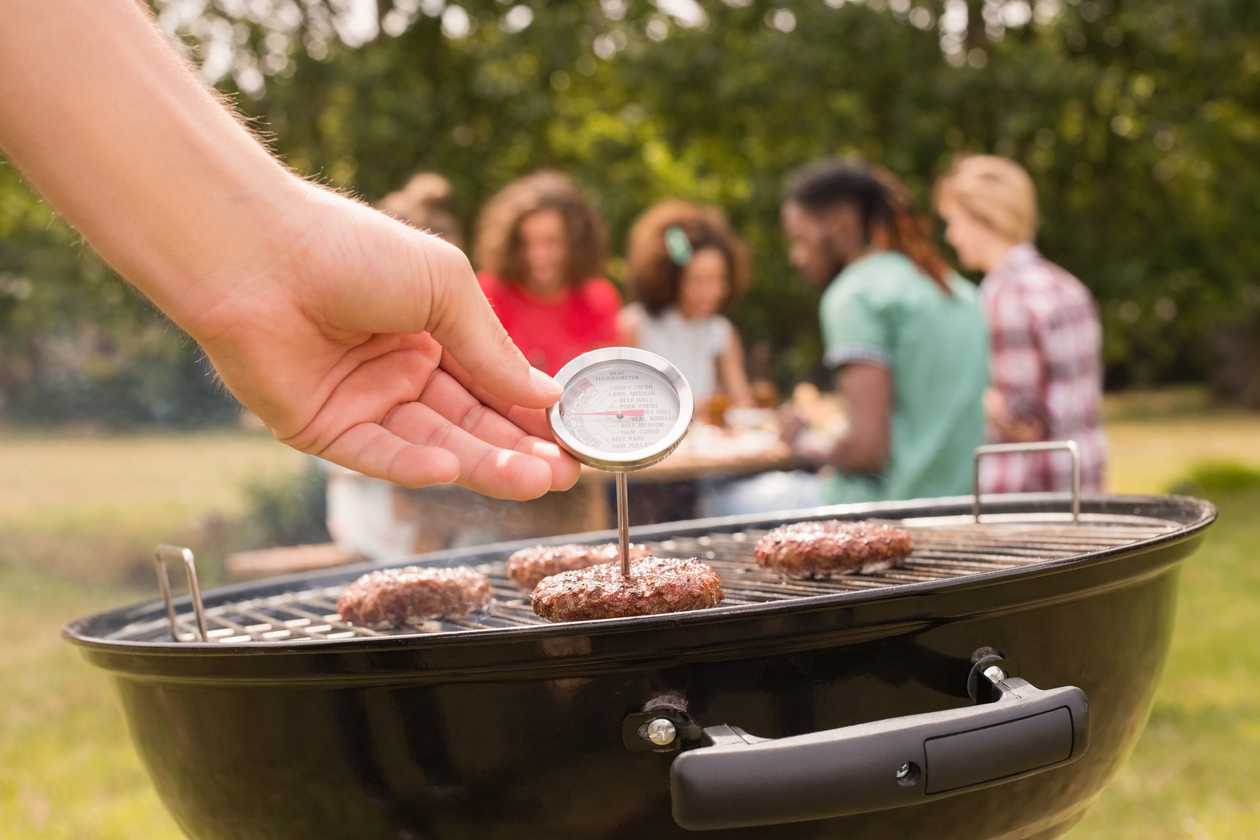Our evaluations and opinions are not influenced by our advertising relationships, but we may earn a commission from our partners’ links. This content is created independently from TIME’s editorial staff. Learn more about it.
It can be heartbreaking to buy an expensive steak, only to accidentally overcook it and end up with something resembling a rubber chew toy. And it can be a whole lot worse than that if you go the other direction—and accidentally serve up undercooked chicken. Our picks for the best meat thermometers help you avoid both of these mishaps by indicating your food’s precise internal temperature. Because yes, cooking is an art, but it’s also a science.
What to consider before buying a meat thermometer
The main thing to know about meat thermometers is just how vital they are to cooking a meal properly. After all, even the best grills and ovens can’t tell you if the food you’re making is the right temperature for maximum flavor (and safety).
Overall design
“Cooking is all about temperature control,” says author and Barbecue Hall of Famer, Meathead Goldwyn. “You must know what the temp of your cooker is and what temp the food is in order to gauge doneness and safety. You cook with a thermometer, not a clock! Any recipe writer that says something like, ‘Cook for five minutes on one side and three minutes on the other,’ or, ‘Cook till the juices run clear,’ is guilty of malpractice,” Goldwyn jokes. Any meat thermometer you purchase should first and foremost have a clear display that’s easy to read at a glance.
Function
If you mostly cook in the oven or inside a closed grill, you’ll need something designed to stay in the meat and send you the temperature remotely, so you don’t have to keep opening up the lid or door and letting all the heat out. For those cooking mostly on stovetop, a handheld meat thermometer will work fine, and likely be less expensive.
Ease of use
Again, if you’re hovering by the stove, a simple handheld device with a large, easy-to-decipher readout is ideal. If you’re planning on leaving something cooking all day, however, you’ll want to opt for a thermometer that you can monitor via a connected app on your phone.
Our picks for the best meat thermometers
The best wireless meat thermometer: Fireboard Spark Instant Read Thermometer
For long, slow cooking, a wireless thermometer can take the hassle out of monitoring temperature. “If you’re cooking something like a brisket, which can take 12 hours, you can put the probe in there, go to work downtown and read the temperature of your brisket on your phone or computer,” says Goldwyn. Fireboard’s universally popular Spark already works wonderfully well as a handheld digital thermometer, but it’s the optional leave-in food probe ($15) and simple-to-use app that makes it such an appealing pick for anyone looking to leave their grill unattended for a while.
Specifications:
- Price: $149 (plus $15 for the leave-in probe)
- Accuracy claim: Within 0.7 degrees Fahrenheit
- Temperature range: -58 to 572 degrees Fahrenheit
- Power source: Rechargeable lithium-ion battery
- Battery life: 12 hours
Pros:
- Easy-to-read LED display
- Well-rated app
- Durable
Cons:
- Leave-in probe sold separately
- Expensive
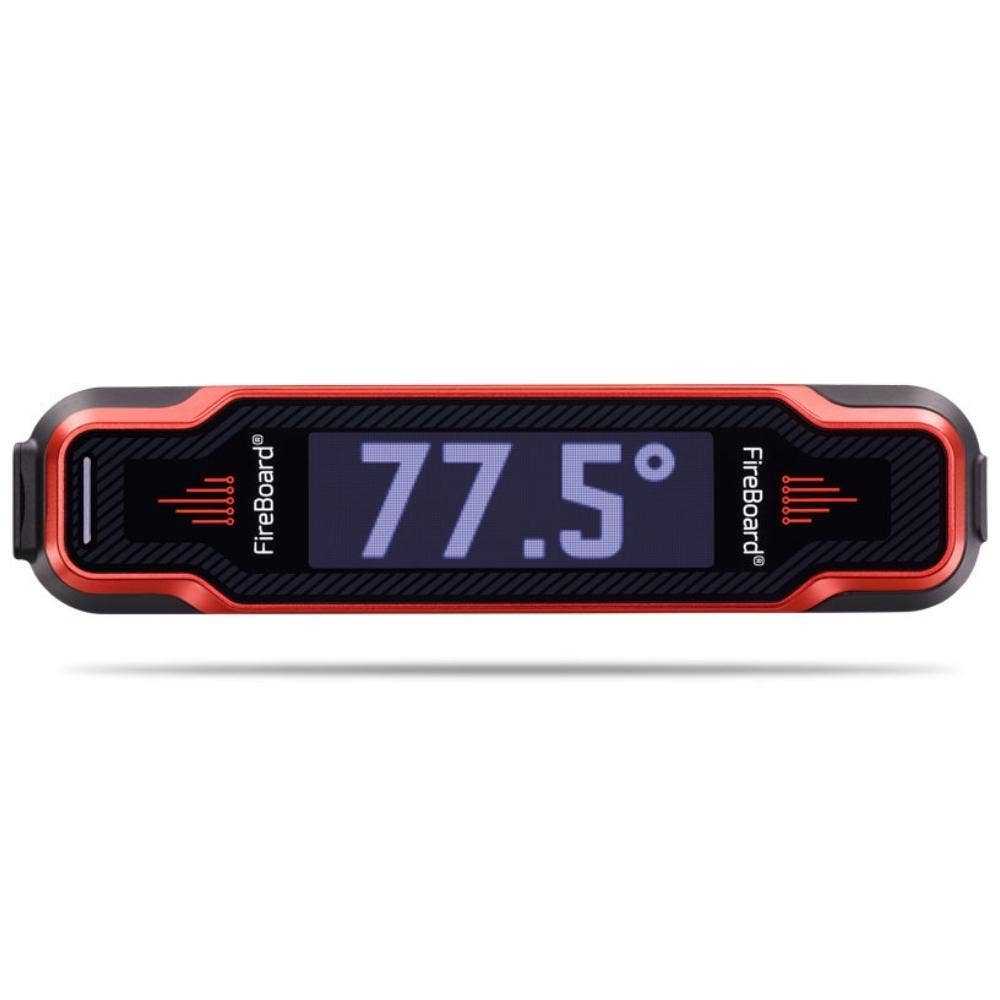
Fireboard Spark Instant Read Thermometer
The best instant read meat thermometer: Thermoworks Thermapen ONE
Most decent digital thermometers will give you an accurate reading within a few seconds, but if you absolutely can’t wait that long, you’ll love the blisteringly fast Thermapen ONE, which gives results in just one second (hence the name). It’s also durable, a cinch to use, and comes in ten colors. It might be on the pricier end for a digital thermometer, but you get your money’s worth.
Specifications:
- Price: $99.95
- Accuracy claim: Within 0.5 degrees Fahrenheit
- Temperature range: -4 to 248 degrees Fahrenheit
- Power source: 1 AAA battery
- Battery life: 2,000 hours
Pros:
- One-second read time
- Easy to use
- Smart backlight display that comes on in low light
Cons:
- Expensive
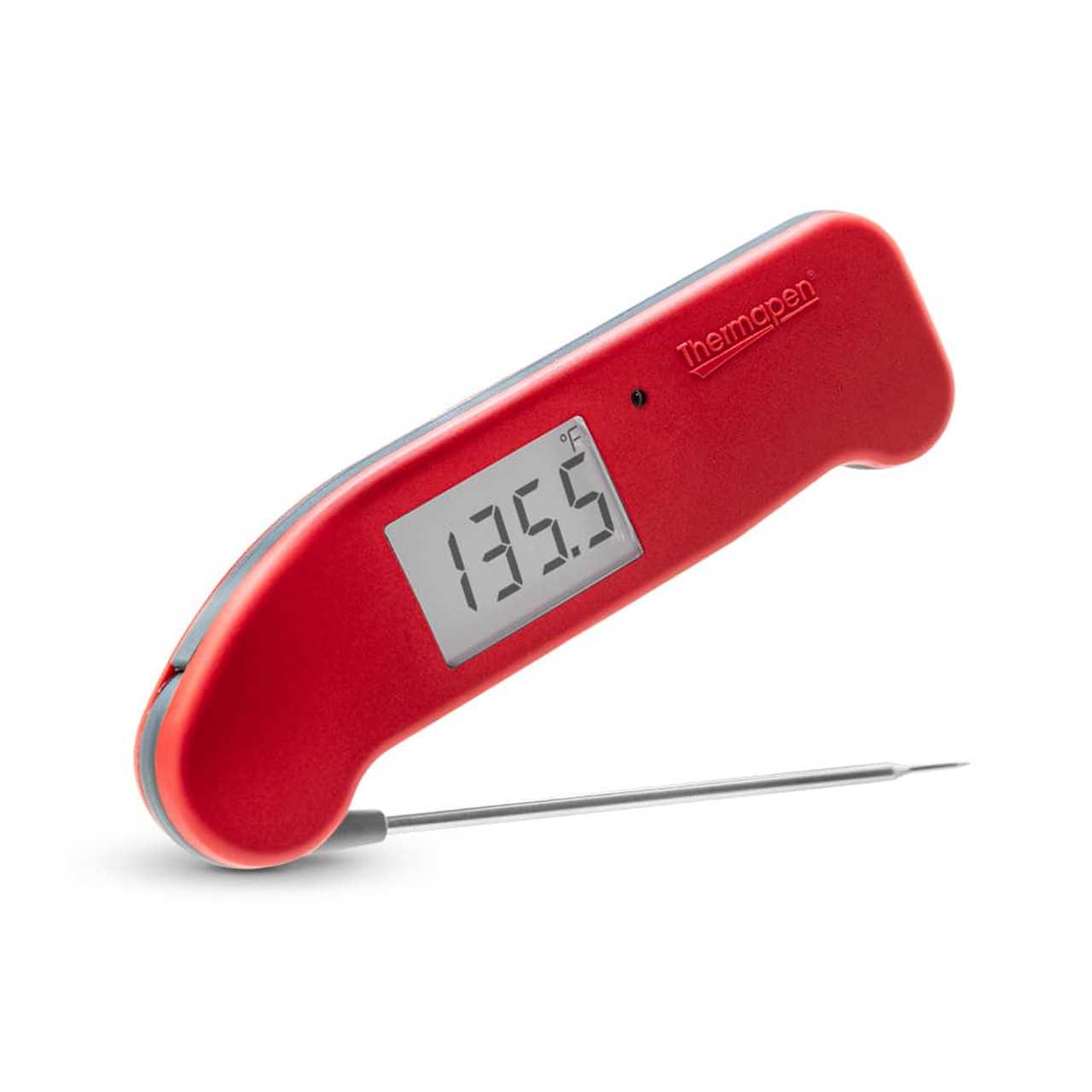
Thermoworks Thermapen ONE
The easiest to use meat thermometer: Oxo Thermocouple Thermometer
Ease of use is, understandably, a top consideration for some, and this fast, accurate thermometer wins that category comfortably. Its large, white-on-black display makes it simple to read in any light, while its ability to rotate 225 degrees makes it more convenient for left-handers to, well, handle. It has an IP66 waterproof rating, too, meaning it can be safely cleaned under running water (although not submerged). All that, and it can still give you a reading in just two to three seconds.
Specifications:
- Price: $104.99
- Accuracy claim: Within 0.9 degrees Fahrenheit
- Temperature range: -58 to 572 degrees Fahrenheit
- Power source: 2 AAA batteries
- Battery life: 43 hours
Pros:
- Fast read time
- Easy to read
- Easy to clean
Cons:
- Switch to toggle between fahrenheit and celsius is inside battery compartment
- Expensive
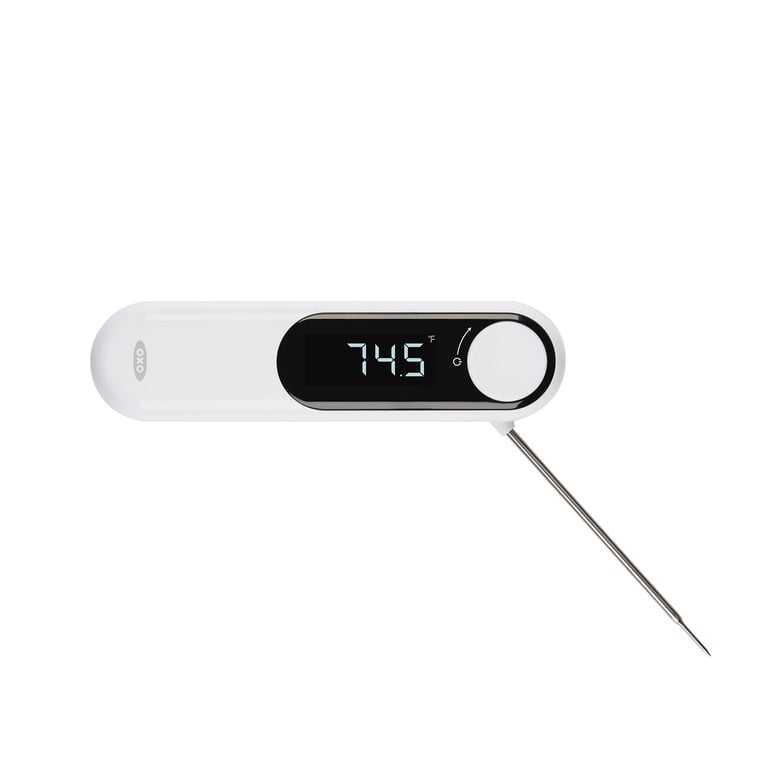
Thermocouple Thermometer
The best thermometer for grilling meat: ThermoPro TP-450 Dual Laser Infrared Temperature Gun
One of the trickiest parts of grilling is getting an accurate read on the temperature of your grill surface. “The thermometer that comes built into your grill is at the top of the dome—that’s eight inches away from the meat, it’s a different temperature up there,” points out Goldwyn. “You need to take the temperature at the same location as the meat. It’s also going to be one of those dial thermometers, which is technology created in the 1800s.” Show the 19th century who’s boss, then, with an infrared thermometer: Simply point the device’s twin lasers at your grill surface (or the inside of your freezer, or the top of the food you’re cooking, or anything else) for an accurate reading. While there are certainly higher end infrared options out there, ThermoPro’s TP-450 is easily the best value for money, coming in at less than half the price of comparable models.
Specifications:
- Price: $32.99
- Accuracy claim: Within 1.5%
- Temperature range: -50 to 1,022 degrees Fahrenheit
- Power source: 2 AAA batteries
- Battery life: Not listed
Pros:
- Great value
- 0.5 second read time
Cons:
- You can’t measure the internal temperature of your food with this, so you’ll need a regular meat thermometer, too
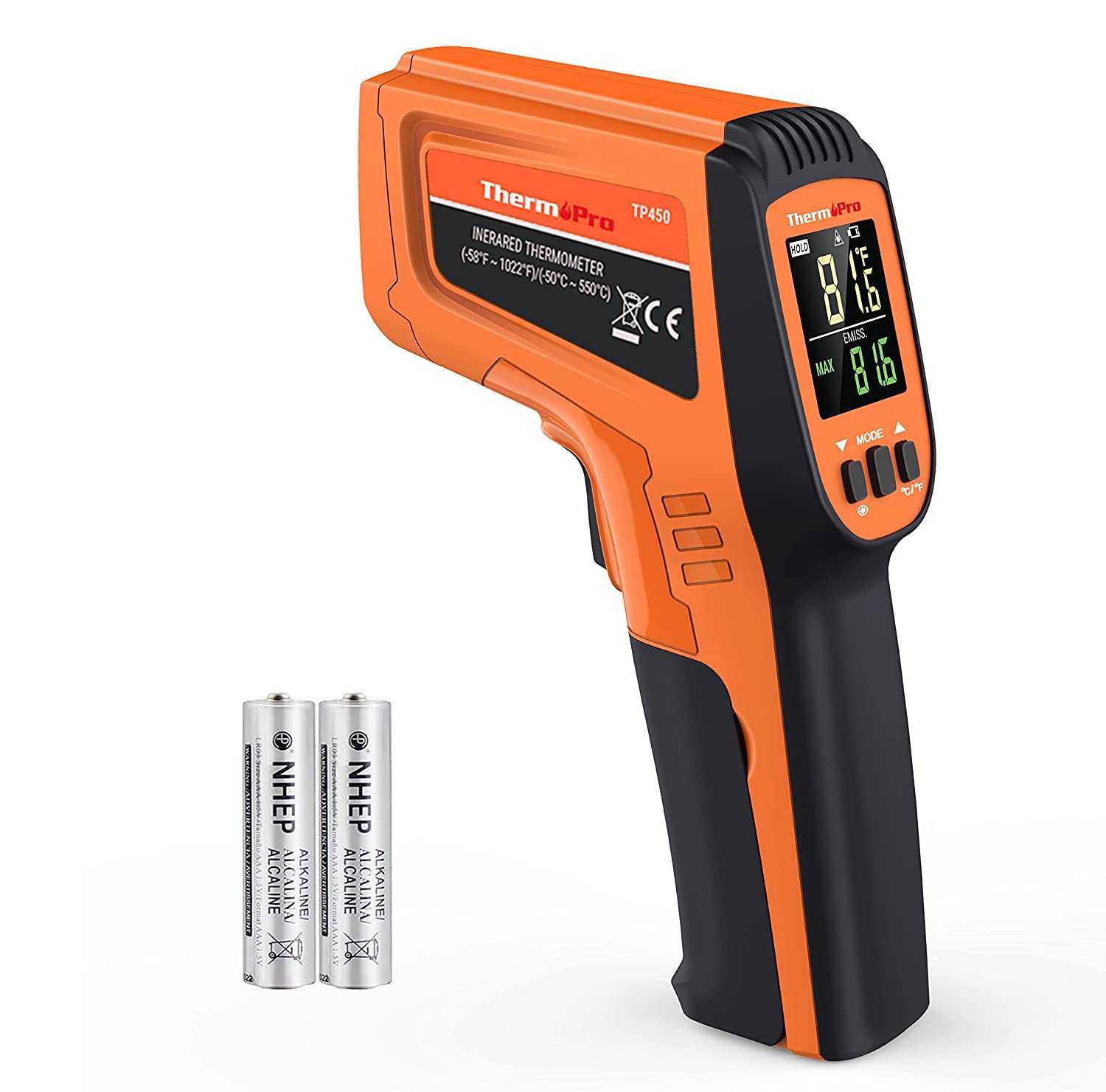
ThermoPro TP-450 Dual Laser Infrared Temperature Gun
The best meat thermometer for smoking: FireBoard 2 Drive Wireless Thermometer
This one is for hardcore barbecue tech lovers, with temperature graph displays, channels for up to six external temperature probes, Wi-Fi and bluetooth compatibility, and a temperature history logger. Most importantly for smoking, it can be paired with the Fireboard Drive Blower ($59) to actually control your cooker temperature from afar, rather than just keeping track of it. The overall price may make your eyes water, but at least the results will do the same for your mouth.
Specifications:
- Price: $249 (plus $59 for the Blower)
- Accuracy claim: Within 0.7 degrees Fahrenheit
- Temperature range: -94 to 752 degrees Fahrenheit
- Power source: Rechargeable lithium-ion battery
- Battery life: 30 hours
Pros:
- Large, easy to read LCD screen
- Sturdy design
- Supports up to six probes
Cons:
- Very expensive
- Blower attachment is sold separately
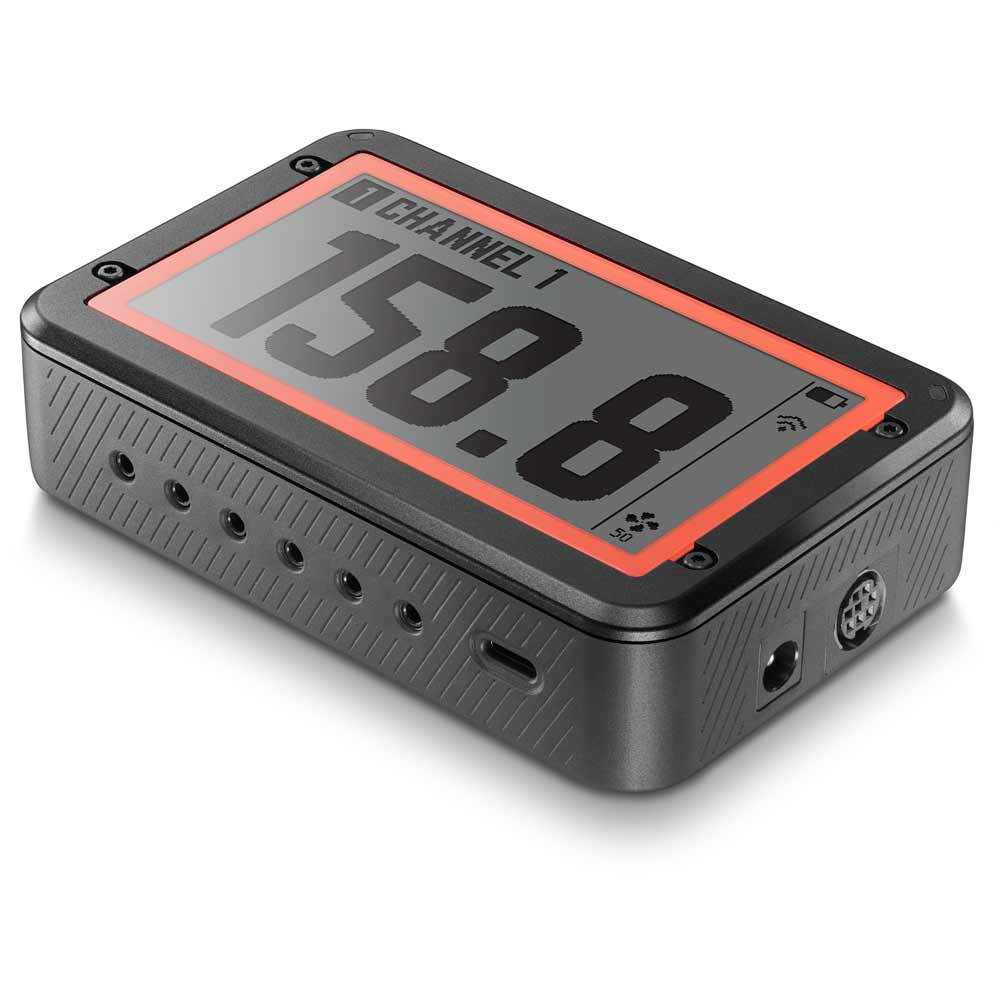
FireBoard 2 Drive Wireless Thermometer
The best in-oven meat thermometer: Maverick Remote BBQ & Smoker Thermometer XR-50
You might think that your oven’s own temperature gauge would be accurate, but Goldwyn disagrees. “When you set your oven to 300, it doesn’t go to 300 and stay there. It goes to 310, then it drops down to 290, then goes back to 310, drops down to 290. Most of your indoor ovens are way off, mine was off by 25 degrees. That’s not a problem when you’re cooking meat, usually, but if you’re baking, oh yeah.” To get a good reading on what’s happening to your food in the oven, the XR-50 allows you to insert up to four probes (two three-inch, two six-inch) and get temperature alerts from up to 500 feet away.
Specifications:
- Price: $79.99
- Accuracy claim: Not listed
- Temperature range: 14 to 572 degrees Fahrenheit
- Power source: 4 AAA batteries
- Battery life: Not listed
Pros:
- Rugged build
- Water resistant
Cons:
- Some reviews claim the stands on the back of the receiver and transmitter fold too easily
The best meat thermometer for large joints: ThermoPro TP-15 Instant Read Thermometer
Getting a thermometer to the center of a large slab of meat can be tough, but it’ll be even tougher if you overcook it, so it’s worth the effort. The TP-15 features a long, 5.36-inch probe, with a convenient thinner tip for more easily puncturing the surface. The unit’s three- to four-second response time is super fast considering its price—overall, this is a convenient, cheap device to keep handy for the handful of times you’ll need it.
Specifications:
- Price: $14.99
- Accuracy claim: Within 0.9 degrees Fahrenheit
- Temperature range: -58 to 572 degrees Fahrenheit
- Power source: 1 CR2032 coin battery
- Battery life: Not listed
Pros:
- Extremely inexpensive
- Fast
Cons:
- No frills, but for the price, it’s still a bargain
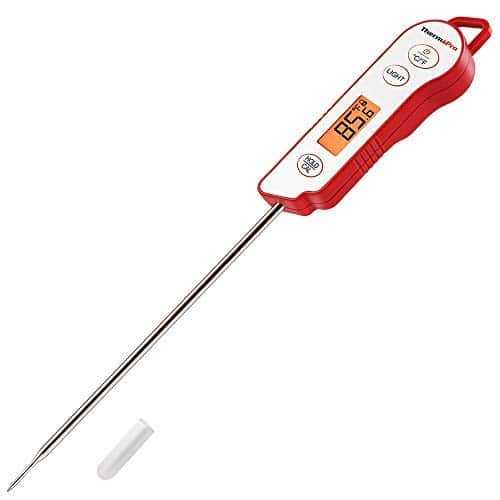
ThermoPro TP-15 Instant Read Thermometer
The best value meat thermometer: ThermoWorks ThermoPop 2
Thin, light, and easy to hold and use, the ThermoPop 2 finds that sweet spot between being inexpensive and giving you exactly what you need. The large, backlit, auto-rotating screen is pretty much foolproof, with the reading popping up in just two to three seconds. You can even drop it in the sink (briefly) without ruining it, and it comes in nine colors.
Specifications:
- Price: $35
- Accuracy claim: Within 1 degree Fahrenheit
- Temperature range: -58 to 572 degrees Fahrenheit
- Power source: 1 CR2032 coin battery
- Battery life: 4,000 hours
Pros:
- Option of either 4.5- or 8-inch probe
- Easy to use
- Inexpensive
Cons:
- Some reviewers complain that it’s easy to lose the case
- Eight-inch probe is slightly slower to give a reading (three to four seconds)
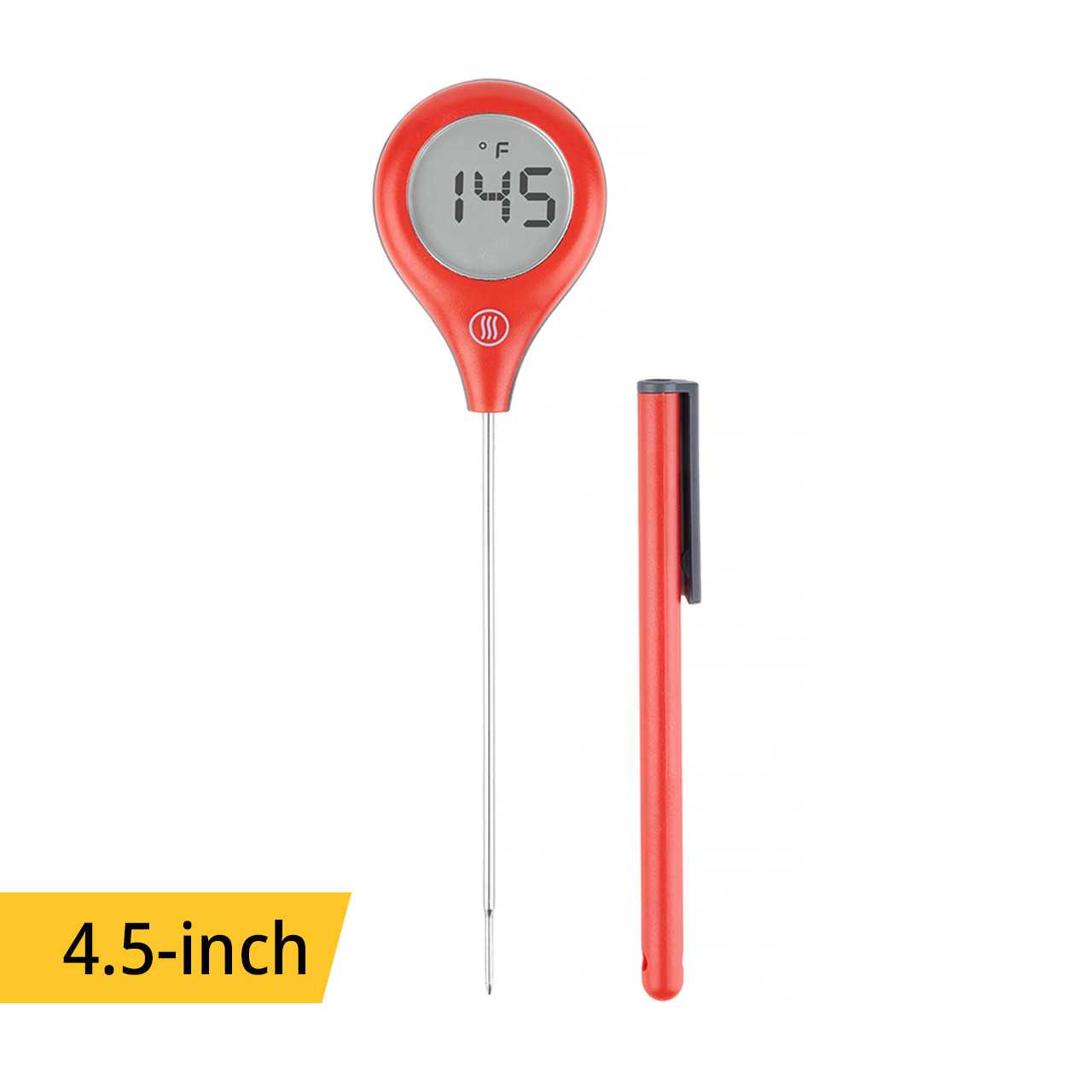
ThermoWorks ThermoPop 2
The best high-end meat thermometer: Typhur Sync Wireless Meat Thermometer
At the other end of the scale is Typhur’s gorgeously sleek Sync Wireless meat thermometer. Featuring two individual (and handily labeled) probes, each with six separate sensors, it gives you the option of either tracking your progress on a well-designed and simple-to-pair phone app, or–if you’re satisfied with a little less detail–on the monitor itself. Doubling as a charging case and bluetooth/wi-fi bridge, the monitor is easy to read and has a stand that allows you to set it at multiple angles for easier viewing.
Specifications:
- Price: $229
- Accuracy claim: Within 0.5 degrees fahrenheit
- Temperature range: 32 - 212 degrees fahrenheit
- Power source: 3.7 volt battery
- Battery life: 50+ hours
Pros:
- Can be used with a smartphone app or just by itself
- Probes are dishwasher safe
- Looks great
Cons:
- Expensive
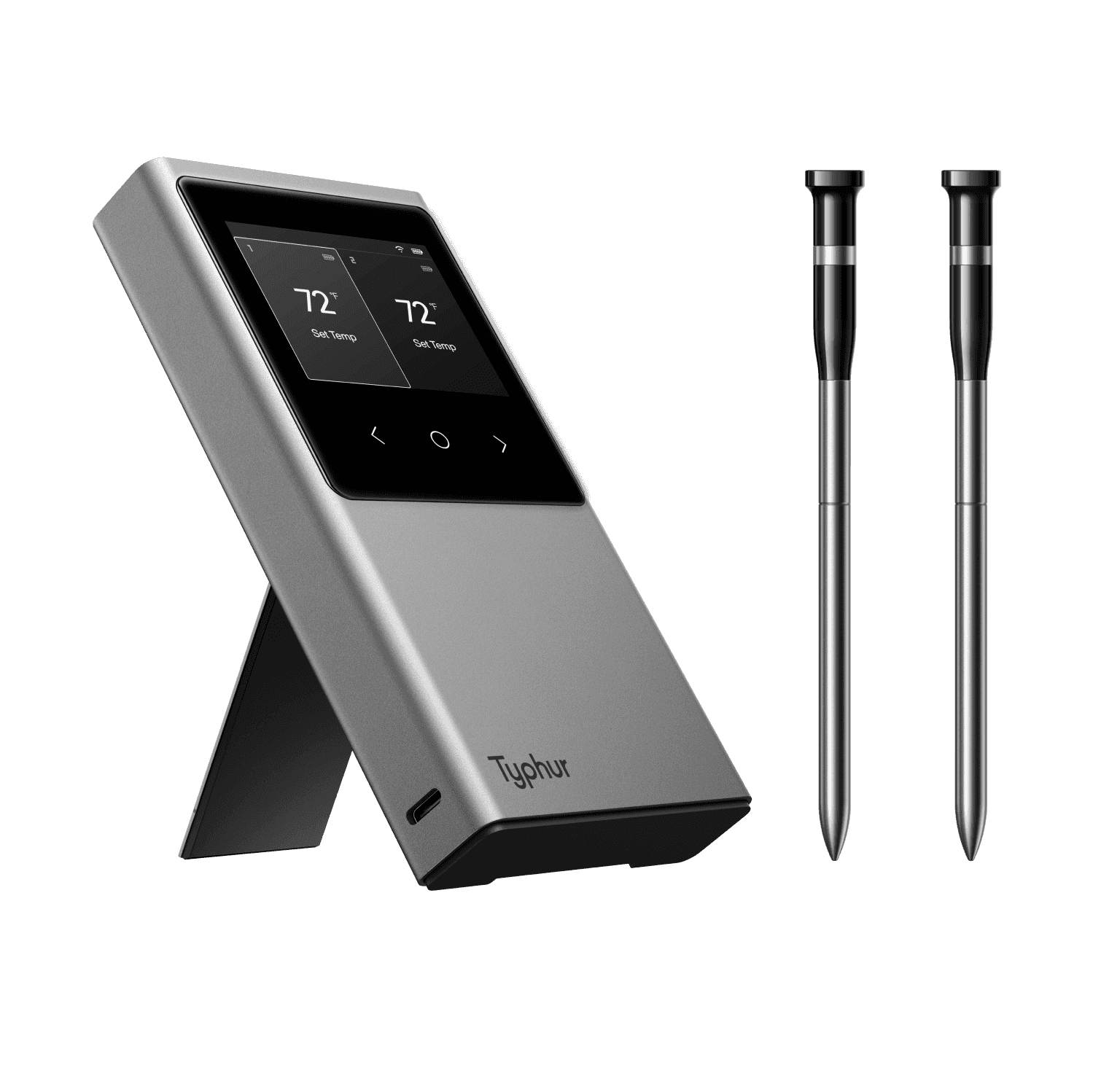
Typhur Sync Wireless Meat Thermometer
How we chose the best meat thermometers
We made our picks based on extensive research and personal experience on the top concerns home cooks have when shopping for a meat thermometer, along with the best-reviewed thermometers that have performed well over time. In addition, we sought expert opinions for factors shoppers may overlook on their purchase, and exhaustively researched first-hand reviews.
How to use a meat thermometer
“You need to measure in the geographic center,” says Goldwyn. “It’s the thickness of the meat or vegetables that determines how long it takes to cook—a turkey breast takes longer to cook than a chicken breast, because a turkey breast is much thicker. So you need to measure the temperature in the center of the thickest part.”
How to read a meat thermometer
“With the digital ones, you just read the number!” says Goldwyn. “Of course, you need to know the numbers: Medium rare steak is at its most tender and most juicy at 130 to 135 degrees. Medium is 140, well done is 155. If you want a medium rare steak, you need to know what is the right temperature. And you need to know that poultry is more risky than any other kind of meat, you need to cook it to that 160 to 165 range.”
What are the benefits of using a meat thermometer?
“With a meat thermometer, you’ll never overcook a meal again,” enthuses Goldwyn. “And it’s not just something like steak, which is expensive. It’s a safety issue: Consumer Reports did a research project where they went out and bought 300 chicken breasts and tested them. They found 90% had pathogenic bacteria. The bacteria all die if you cook them to 160 to 165 degrees, so they’re perfectly safe if you cook them with a thermometer. You don’t want to send Grandma to the hospital on the fourth of July.”
How to use a meat thermometer in an oven
Once you’ve set up the monitor or app you’ll be using to track the temperature, in-oven thermometers are fairly straightforward. Simply insert the probe a couple inches into whatever it is you’re cooking (if it’s a large piece of meat, opt for the thickest section). Make sure you haven’t accidentally left the probe touching anything that will throw off your reading—the edge of the baking tray, for example, or a piece of bone or fat that will heat up differently to the actual meat—then close the door and monitor your progress from the comfort of wherever you like!
How to use a meat thermometer when cooking on the stove
Stove-top cooking is even easier when it comes to meat thermometers. For the most accurate reading, remove the meat from the pan first, then insert the probe into the thickest part of the cut—once again avoiding bone, fat, the edge of the pan, etc.—and see what the readout says. If it’s not there yet, just give it a little more time.
Frequently asked questions (FAQs)
Is it worth buying a meat thermometer?
Naturally, Goldwyn says yes. “Steak is expensive! You don’t want to have company over and buy ribeyes and overcook them,” he says. “A medium rare steak is 130 to 135 degrees Fahrenheit, not a penny more, not a penny less. You can’t tell for sure by cutting into it, because the inside of meat is anaerobic, there’s no oxygen. As soon as you give it oxygen [by cutting into it], the oxygen changes its color.”
“People worry that if you poke a hole in it [with a thermometer], it’s going to dry out,” Goldwyn continues. “That’s just not the case. A steak is 75% water: If you buy an eight-ounce filet mignon, it’s six ounces of water. If you lose three or four drops, you haven’t run it dry. You can stab it several times, it’s not going to hurt it.”
Where should you put the meat thermometer in a turkey?
“In the thickest part of the breast,” says Goldwyn. “It’s where they put that pop-up thermometer. Unfortunately, that pop-up thermometer is generally set for around 180 degrees [rather than 165], because [the turkey sellers] don’t want to be sued. At 180, the turkey is cardboard.”
Which is better, an analog or digital meat thermometer?
It’s not even close, which is why you won’t find any analog thermometers on our list. “Those dial thermometers are not accurate and they’re extremely slow,” warns Goldwyn. “If you have one of those, take it out, bring it to your driveway and back over it with your car,” he says. “This is the digital age, digital thermometers are extremely accurate and they can be very fast. The high-end ones, in the $80 to $100 range, can give you a precision reading in one or two seconds. But you don’t have to spend that much, there’s some really good ones in the $15 to $30 range that will give you a good, precision reading within five seconds.”
What are the most accurate thermometers?
The most accurate thermometers have a digital display (and not a dial with an arrow where you have to guess the result). As for specific brands, Thermoworks is often recommended by professional chefs (and made our list twice). Goldwyn personally is currently a fan of Fireboard for both accuracy and convenience.
The information presented here is created independently from the TIME editorial staff. To learn more, see our About page.

